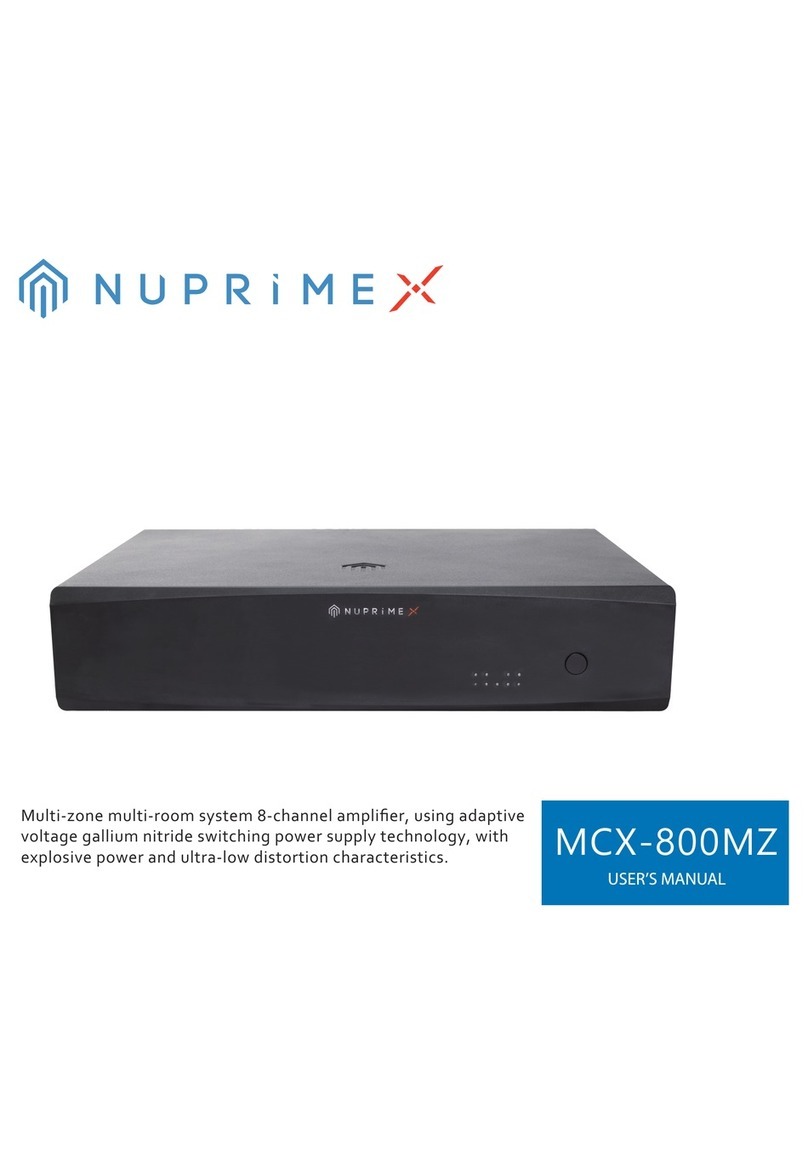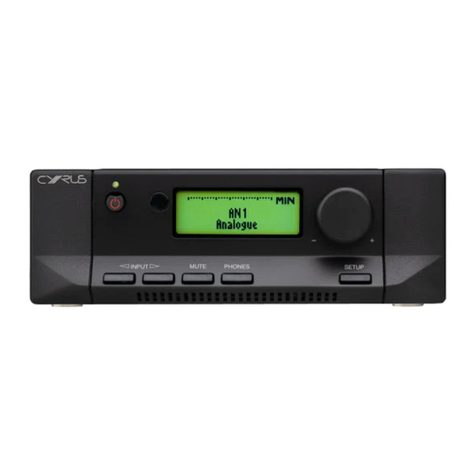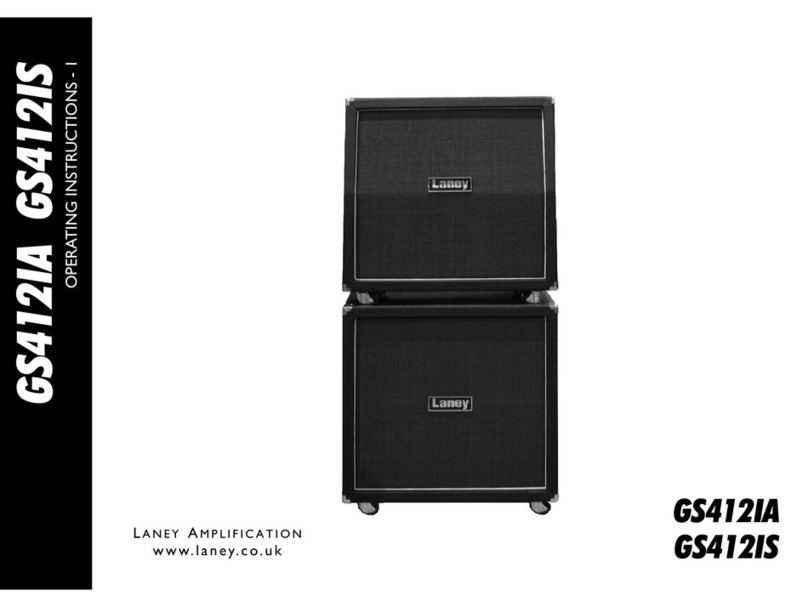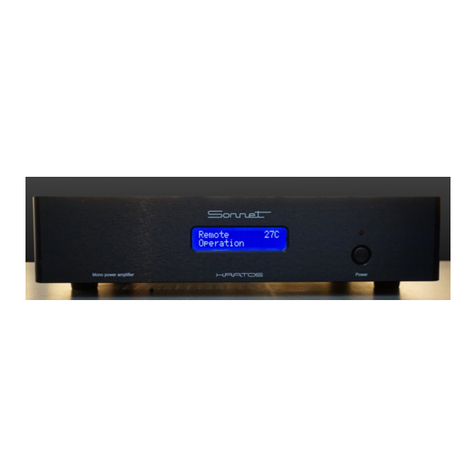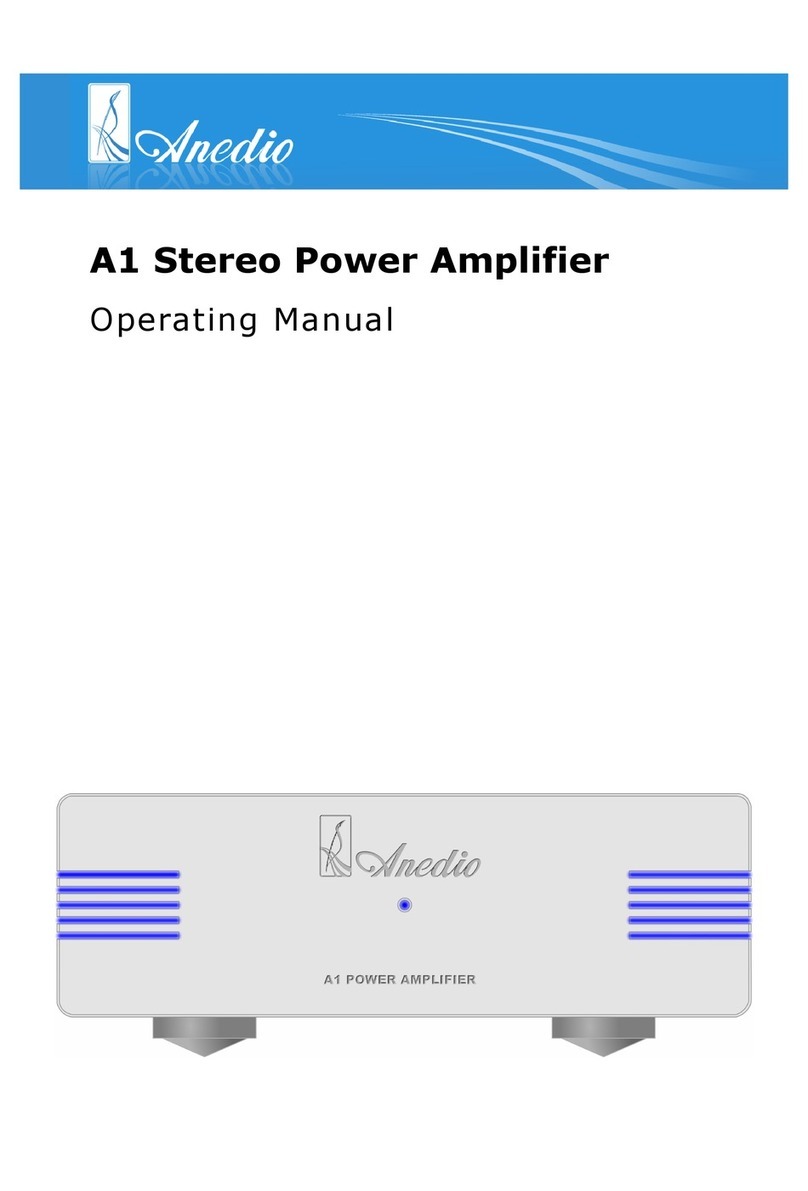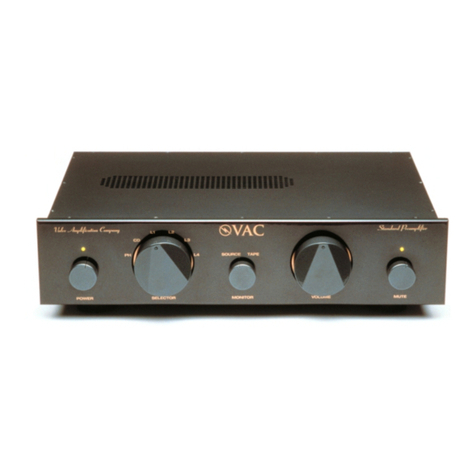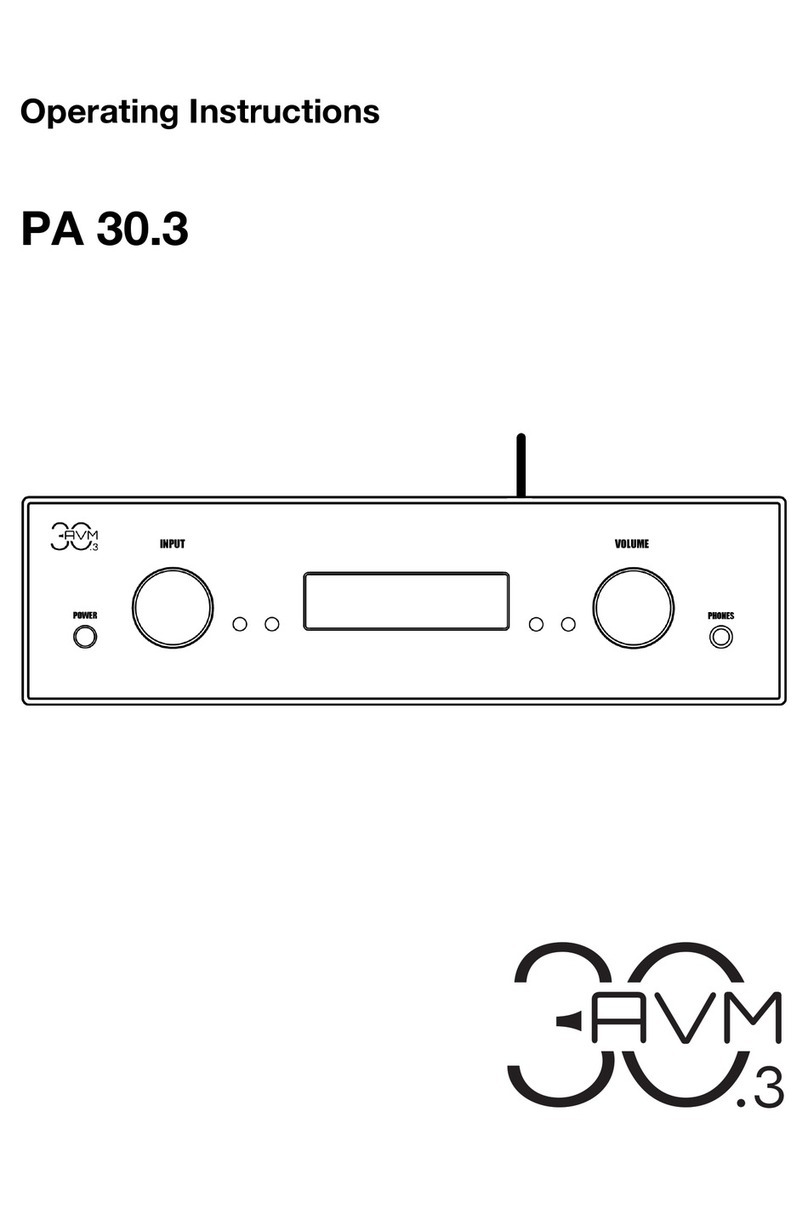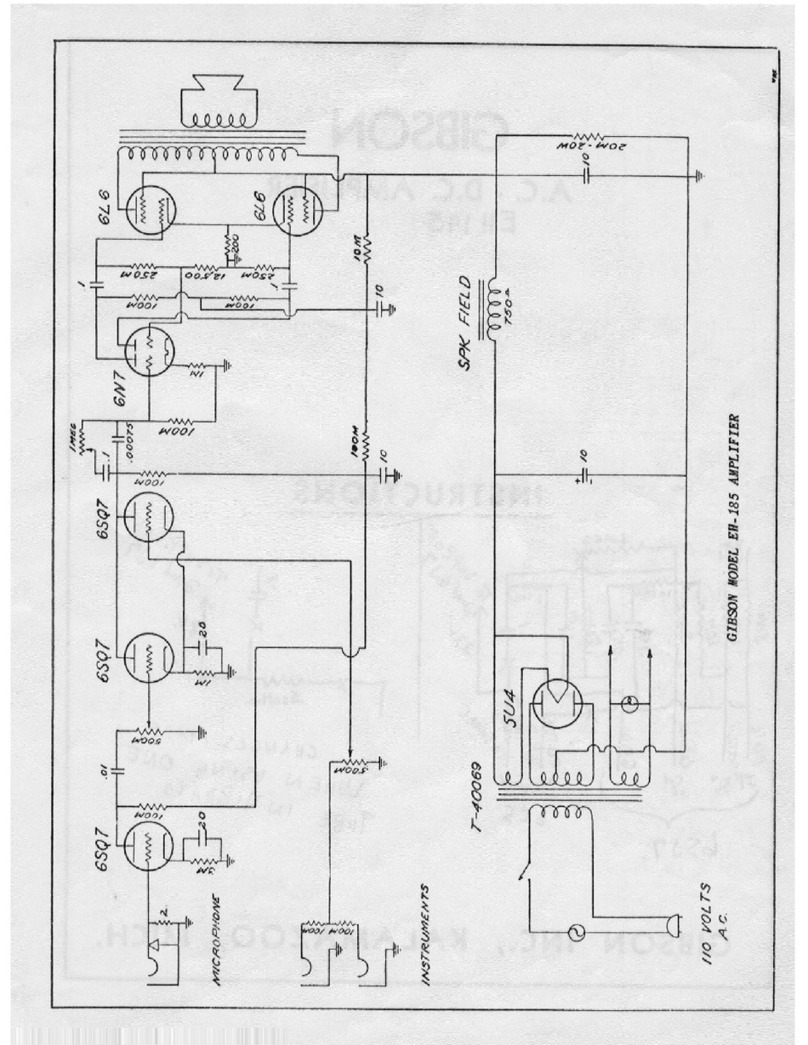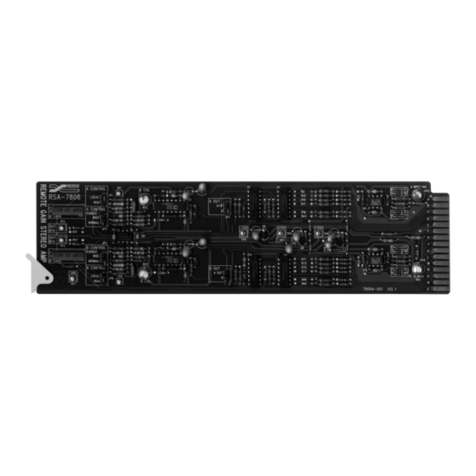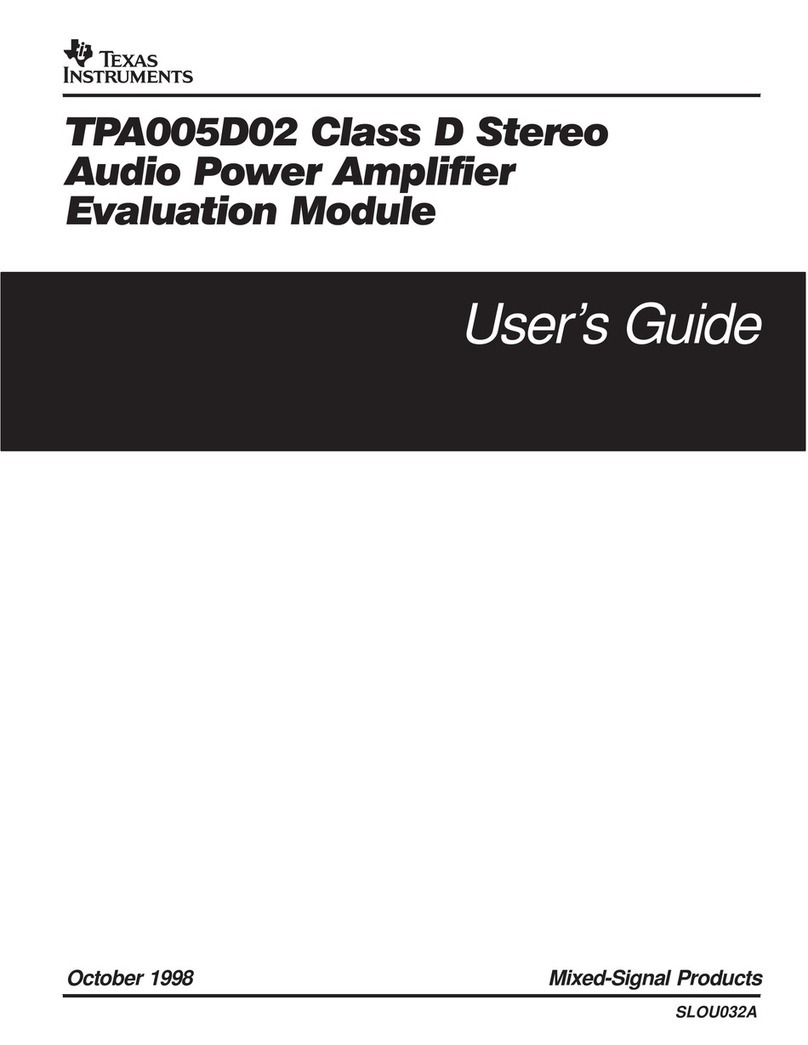Trutone Electronics PAYMER 804-100A User manual

MODEL
804-100A
AMPLIFIER
OPERATING
INSTRUCTIONS
DESCRIPTION
The
Raymer
Model
804-100A
is
a
multi-purpose
100
watt
RMS
monaural
all
silicon
solid
state
amplifier.
It
is
de-
signed
for
dependable,
continuous
operation
in
background
music,
paging,
or
sound
reinforcing
systems.
In
addition
toa
Hi
Z
or
LoZ
microphone
input,
two
music
inputs
are
available
for
use
with
a
tuner,
a
high
output
ceramic
or
crystal
phono,
a
tape
recorder
with
its
own
preamp,
or
other
auxiliary
equipment.
Model
804-100A
is
supplied
with:
separate
bass
and
treble
controls,
which
may
be
used
to
compensate
for
room
and
speaker
characteristics.
A
special
switch
is
provided
to
protect
a
trumpet
speaker
diaphragm
from
low
frequency
power.
The
amplifier
has
speaker
outputs
of
16
ohms,
25
volt
and
70
volt
balanced
or
unbalanced
lines.
The
amplifier
also
features
an
electronic
switching
(PRECEDENCE)
circuit
in
place
of
a
relay
to
quickly
fade
out
the
music
while
paging;
after
the
page,
the
music
is
smoothly
restored.
The
precedence
feature
operates
only
on
the
music
input.
Model
804-100A
is
equipped
with
an
interlock
feature
which
permits
connecting
together
two
or
more
804-100A
Amplifiers
so
that
they
may
be
operated
simultaneously
to
deliver
a
total
power
in
multiples
of
100
watts
into
a
speaker
line.
UNPACKING:
|
The
unit
is
to
be
removed
carefully
from
the
carton
and
inspected
for
any
possible
damage
in
transit.
If
there
is
any
evidence
of
any
damage
which
might
have
occurred
in
shipment,
notify
your
dealer
at
once,
or
the
transportation
company
which
delivered
it.
Claims
for
damage
sustained
in
transit
must
be
made
upon
the
Carrier.
Save
all
packing
material
for
inspection
by
the
claim
agent
who
will
furnish
you
with
the
proper
forms
and
will
also
give
you
the
necessary
instructions
for
filing
a
claim.
In
addition
tothe
Unit,
there
should
bea
warranty
card
included
in
the
carton.
To
insure
proper
servicing
and
to
protect
your
rights
under
the
warranty,
be
sure
to
fill
in
the
warranty
registration
card
without
delay
and
mail
to
the
factory.
INSTALLATION:
Mode!
#804-100
amplifier
has
ample
vents
for
normal
ventilation;
however,
it
should
be
placed
so
as
to
permit
free
air
flow
around
the
unit.
DO
NOT
PLACE
ANY
OBJECT
ON
TOP
OF
THE
PERFORATED
COVER.
DO
NOT
STORE
OR
OPERATE
THE
AMPLIFIER
in
areas
where
the
ambient
temperature
exceeds
140
degrees
F.
Plug
the
AC
line
cord
in
any
outlet
furnishing
105
to
120
volts,
60
cycles
AC.
An
AC
receptacle
is
located
on
the
back
of
the
chassis
to
supply
power
to
other
components
such
as
phonograph
motor,
etc.
The
auxiliary
equipment
connected
to
the
AC
receptacle
is
controlled
by
the
POWER
on-off
switch
so
that
turning
off
the
unit
turns
off
all
equipment.
CONNECTIONS:
All
connections
are
made
on
the
rear
panel
of
the
unit,
and
are
clearly
identified.

CONTROLS
AND
INPUT
CONNECTIONS
The
music
channel
has
two
inputs
depending
on
the
source
of
the
signal.
For
a
high
impedance
input
such
as
a
tuner
or
a
phono
with
its
own
preamp,
or
other
auxiliary
equipment
of
a
similar
nature,
the
input
marked
MUSIC
Hi-Z
should
be
used.
If
the
source
is
a
balanced
line
such
as
a
telephone
line,
the
500
OHM
input
may
be
used
with
the
plug-in
transformer
(either
UTC
#P-1,
Microtran
#M1-P,
or
equivalent)
installed
in
the
octal
socket
on
the
chassis.
The
500
ohm
input
phono
jack
is
not
grounded
so
that
the
input
from
a
balanced
line
may
be
connected
to
the
two
leads
of
a
phono
plug.
As
an
alternate
to
the
use
of.a
plug-in
transformer,
Raymer
Telephone
Matching
Adaptor
TM-1
may
be
connected
to
the
MUSIC
Hi-Z
input.
The
MICROPHONE
input
is
for
an
unbalanced
line
only.
If
it
is
desirable
to
use
a
balanced
input,
an
outboard
matching
transformer
must
be
used.
The
switch
above
the
microphone
input
selects
the
proper
input
impedance.
The
Hi-Z
position
will
match
either
crystal
or
high
impedance
dynamic
microphones;
the
Lo-Z
position
will
match
microphones
in
the
150
to
500
ohm
range.
To
avoid
possible
supersonic
oscillation
which
might
result
in
damage
to
the
unit,
it
is
mandatory
that
a
shielded
(metal
cover)
microphone
plug
be
used.
In
the
event
a
telephone
switchboard,
a
dial
access
telephone,
or
internal
telephone
system
is
used
as
a
paging
source
in
place
of
a
microphone,
the
Raymer
TM-1
Adaptor
may
be
used
to
match
the
telephone
line
to
the
microphone
input.
The
Bridging
jack
may
be
used
for
either
input
or
output
applications,
It
is
connected
electrically
between
the
pre-
amplifier
and
power
amplifier
sections
of
Model
804-100,
and
may
therefore
be
used
(1)
as
the
output
of
the
pre-
amplifiers
into
an
external
amplifier
and/or
tape
recorder,
or
(2)
from
the
output
of
an
external
source
into
the
power
amplifier
section.
When
the
Bridging
jack
is
used
to
feed
an
external
amplifier
or
tape
recorder,
the
Bridging
circuit
is
not
affected
by
the
Master
Volume,
Bass,
and
Treble
controls.
When
the
Bridging
jack
is
used
as
the
input
from
an
external
source
(such
as
a
microphone
mixer-preamplifier
when
additional
microphones
are
required)
the
reproduction
from
the
external
source
will
be
affected
by
the
Master
Volume,
Bass,
and
Treble
controls.
In
order
to
protect
horn
loaded
drivers
the
switch
marked
TRUMPET
PROTECT/NORMAL
should
be
placed
in
the
"Trumpet
Protect”
position.
This
reduces
the
bass
frequencies
and
protects
the
driver
diaphragms.
For
use
with
cone
type
loudspeakers
the
switch
should
remain
in
the
“Normal”
position.
The
separate
Bass
and
Treble
controls
provide
a
flat
response
when
set
in
a
center
position.
These
controls
can
either
boost
or
reduce
the
bass
and
treble
to
compensate
for
room
and
speaker
charactersitics.
If
it
is
desirable
to
fade
out
the
music
while
paging,
a
“dispatcher”
type
of
microphone,
such
as
Raymer
Model
201,
or
an
equivalent
microphone
with
an
auxiliary
switch
should
be
used.
The
microphone
is
to
be
connected
as
shown
in
Figure
1,
PHONE
PLUG
MUST
HAVE
METAL
COVER
MIC.
MIC.PRECEDENCE
“DISPATCHER"
TYPE
MICROPHONE
RAYMER
201
OR
EQUIV.
wo)
Le,
W—
CONTROL
CIRCUIT
FIGURE
13
TYPICAL
CONNECTION
FOR
A
SINGLE
MICROPHONE,FOR
MORE
THAN
ONE
MICROPHONE,CONNECT
CONTROL
CIRCUITS
IN
PARALLEL.
OUTPUT
CONNECTIONS
All
connections
are
made
on
the
rear
of
the
unit.
The
INTERLOCK
jack
is
connected
electrically
between
the
preamplifier
and
power
amplifier
section
of
Model
804-100A.
It
may
either
be
used
as
the
output
of
the
preamplifier
into
an
external
amplifier
or
tape
recorder,
or
to
connect
additional
Raymer
804-100A
Amplifiers
for
increased
power
to
a
speaker
line.
By
inter-connecting
the
INTERLOCK
jack
of
two
or
more
Raymer
100
watt
amplifiers
with
a
patchcord,
they
may
be
operated
simultaneously
to
deliver
a
total
output
power
in
multiples
of
100
watts
into
one
speaker
line.

As
an
example:
The
70
volt
outputs
of
the
two
100
watt
Raymer
amplifiers
may
be
connected
in
parallel
to
deliver
200
watts
to
a
70
volt
line,
or
in
series
to
deliver
200
watts
to
a
140
volt
line.
If
a
system
requires
300
watts
of
power,
the
25
volt
outputs
of
three
804-100A’s
may
be
connected
in
series
to
drive
a
70
volt
line
with
no
appreciable
mismatch,
The
output
terminals
of
the
804-100A
have
been
phased
at
the
factory
so
that
each
terminal
is
in
phase
with
the
corresponding
terminal
of
any
other
Raymer
804-100A
Amplifier.
For
parallel
or
series
connection,
the
terminals
should
be
wired
as
shown
below.
SON-
PARALLEL
SERIES
FIGURE
2
CAUTION:
BEFORE
OPERATING
AMPLIFIERS
CONNECTED
IN
EITHER
SERIES
OR
PARALLEL,
MAKE
SURE
THE
INTERLOCK
JACKS
HAVE
BEEN
CONNECTED
TOGETHER
BY
MEANS
OF
A
JUMPER
CABLE
WITH
A
PHONO
PLUG
AT
EACH
END.
WHEN
CONNECTING
THE
OUTPUTS
IN
SERIES,
MAKE
SURE
THE
JUMPER
BETWEEN
COMMON
(COM)
AND
GROUND
(GND)
IS
REMOVED.
WHEN
CONNECTING
THE
OUTPUT
IN
SERIES,
MAKE
SURE
THE
CENTER
TAP
TERMINAL
IS
DISCONNECTED
FROM
THE
GROUND
TERMINAL
ON
EACH
UNIT.
THIS
TERMINAL
IS
LOCATED
ON
THE
LEFT
SIDE
OF
THE
OUTPUT
TERMINAL
STRIP.
The
speaker(s)
or
line
matching
transformers
are
connected
to
the
screw
terminal
board
located
on
the
rear
panel.
For
short
distances,
any
ordinary
insulated
wire,
such
as
parallel
lamp
cord,
may
be
used,
Connecting
to
the
25
volt
or
70
volt
tap
on
the
unit
permits
the
use
of
a
number
of
speakers
each
with
its
own
cor-
responding
line
matching
transformer,
thereby
eliminating
the
necessity
of
calculating
impedances.
The
tap
on
the
line
matching
transformer
is
selected
to
give
the
power
desired
for
each
speaker.
The
total
of
all
the
power
settings
should
be
no
greater
than
the
amplifier
output
rating.
Three
output
impedances
are
available.
16
ohms
(40V),
25V
(.6.2
ohms),
and
70V
(50
ohms).
These
outputs
are
balanced
to
ground
by
means
of
a
jumper
on
the
back
panel
connecting
the
center
tap
of
the
output
transformer
and
ground.
If
it
is
desirable
to
operate
the
lines
in
an
unbalanced
mode,
remove
the
jumper
and
connect
a
wire
between
the
terminal
marked
GROUND
and
one
side
of
the
output
line
that
will
be
used.
Long
lines
have
an
appreciable
resistance
with
a
resultant
power
loss.
The
use
of
parallel
matching
transformers
on
either
25
volt
or
70
volt
lines
is
recommended
for
long
distances.
When
it
is
desired
to
have
less
than
15%
power
loss,
the
following
table
may
be
used
as
a
guide
for
the
proper
wire
size
to
be
used.
In
all
cases,
it
is
advisable
to
run
as
heavy
a
wire
as
possible
consistent
with
the
requirements.
MAXIMUM
LENGTH
OF
LINE
BETWEEN
OUTPUT
AND
LOAD
16
Ohms
(40V)
6.2
Ohms
(25V)
50
Ohms
(70V)

Optimum
performance
of
any
transisiui
amplifier
depends
on
the
proper
current
delivered
at
the
output
terminals.
Connecting
a
total
load
impedance
at
any
tap
less
than
the
impedance
indicated
on
the
back
panel
of
the
amplifier
will
cause
the
transistors
to
deliver
more
current
than
they
were
designed
for
and
will
deteriorate
the
performance
of
the
unit
and
cause
damage
to
the
transistors.
To
prevent
this
from
occurring
and
to
protect
the
components,
the
unit
is
equipped
with
a
circuit
breaker
that
will
trip
if
the
output
impedance
is
below
the
specified
rated
value;
for
example,
if
two
8
ohm
Speakers
are
connected
in
parallel
(resulting
in
a
4
ohm
impedance),
and
in
turn
connected
to
the
8
ohm
output
terminal,
the
circuit
breaker
will
trip
as
soon
as
the
volume
contro!
is
turned
up
to
the
unit's
maximum
output.
When
output
leads
are
run
near
an
unshielded
microphone
input
plug,
or
when
run
together
with
the
micropheae
precedence
leads,
a
supersonic
oscillation
may
occur.
When
this
does
occur,
it
will
appear
as
a
distortion
in
the
amplifier
output,
and
oftentimes
will
cause
the
circuit
breaker
to
“trip”.
To
prevent
this
oscillation
from
occurring,
it
is
recommended
that
shielded
microphone
plugs
be
used
wherever
possible.
In
the
event
that
an
unshielded
plug
or
a
molded
cable
assembly
is
used,
ik
the
output
leads
away
from
the
Microphone
input(s)
and
Microphone
precedence
leads.
In
installations
where
there
is
no
alternative
but
to
run
both
output
and
microphone
precedence
lines
together,
a
.1
Mfd
capacitor
is
to
be
connected
from
one
side
of
tne
Microphone
Precedence
terminal
to
ground.
This
will
shunt
out
the
feedback
signal
and
more
than
likely
prevent
the
supersonic
oscillation.
The
power
transistors
are
mounted
on
the
back
panel,
In
the
event
it
becomes
necessary
to
replace
these
transis-
tors,
be
certain
that:
No
grit
or
metal
particles
are
lodged
between
the
transistor
and
the
mica
or
back
panel.
The
mica
insulator
is
not
damaged.
Both
sides
of
the
mica
insulator
are
covered
with
Dow
Corning
7
Silicone
Grease
or
equivalent.
SR
FP
>
The
mounting
screws
are
tight,
and
also
that
the
protective
cover
does
not
touch
the
transistor.
CAUTION:
THIS
UNIT
IS
EQUIPPED
WITH
A
CIRCUIT
BREAKER
DESIGNED
TO
PROTECT
THE
TRANSISTORS
AGAINST
OVERLOAD.
IN
THE
EVENT
THAT
THE
CIRCUIT
BREAKER
CONSTANTLY
“KICKS
OUT”,
CHECK
THE
LOAD
ON
THE
OUTPUT
OF
THE
AMPLIFIER
FOR
EITHER
A
SHORT
CIRCUIT
OR
AN
IMPEDANCE
LOWER
THAN
THE
VALUE
RECOMMENDED.
IF
THERE
IS
NO
SHORT
CIRCUIT
AND
THE
LOAD
IS
CORRECT,
CHECK
TO
SEE
IF
POSSIBLY
THE
INPUT
AND
OUTPUT
OR
MICROPHONE
PRECEDENCE
LEADS
ARE
RUNNING
CLOSE
TOGETHER.
IF
THEY
ARE,
THEY
SHOULD
BE
SEPARATED
AND
TREATED
AS
INDICATED
ABOVE.
IN
THE
EVENT
THAT
THE
LOAD
IS
CORRECT
AND
THE
LEADS
ARE
NOT
RUNNING
TOGETHER,
DO
NOT
ATTEMPT
TO
DEFEAT
THE
FUNCTION
OF
THE
CIRCUIT
BREAKER
BUT
HAVE
THE
UNIT
CHECKED
FOR
OTHER
DEFECTS.
WARRANTY
This
unit
has
been
very
carefully
inspected
and
should
require
no
further
service.
Each
unit
is
warranted
to
be
free
from
defects
in
material
and
workmanship
under
normal
use
and
service
for
a
period
of
one
year
from
date
of
delivery
to
the
original
purchaser.
If
this
unit
appears
to
be
defective,
the
factory
will
repair
any
unit
returned
within
said
one
year,
providing
all
transportation
charges
are
pre-paid,
and
which
our
examination
shall
disclose
to
our
satisfac-
tion
to
be
defective.
This
Warranty
does
not
include
free
labor,
nor
is
it
applicable
to
any
unit
which
shall
have
been
subject
to
accident,
tampered
with,
mis-used,
abused,
or
altered
in
any
manner
whatsoever.
Further,
this
Warranty
shall
not
apply
to
any
unit
which
has
been
connected
improperly.
It
is
recommended
that
any
unit
on
which
service
is
required,
be
processed
through
your
dealer
wherever
possible.
This
Warranty
is
expressly
in
lieu
of
all
other
Warranties,
expressed
or
implied,
and
of
all
other
obligations
or
liabil-
ities
on
our
part.
We
neither
assume
nor
authorize
any
other
person
to
assume
for
us
any
other
liability
in
connection
with
the
products
manufactured
by
Trutone
Electronics,
Inc.
TRUTONE
ELECTRONICS,
INC.
7315
FULTON
AVE.,
NORTH
HOLLYWOOD,
CALIFORNIA

OARS
SY
iv
i
UvO
J990%
$
HIGNIONG
dJiJManv
LLYMA
OO!
3
vYOOI-
BOS8
OOON
H3WAVY
1nd4no
WOO!
Ie
MOIZ
INdiNO
"MSE
LV
MOE
WNIS
OYI
IVMGY
Aid
OO!
VK
“v2
‘Q00mMATI0H
“ON
+
+
“INI
SJINOY
19373
INOLNYL
ZHO9
JW'ADZI
Wwa
Yez
z)
Aid
OO}
ve
YY
IYE
LIMAN
(M22
S71OUANOJ
1NOUa
TIY
HLIM
V
A0G
1AJANO
LV
WON
WOWINIM
YO3
Lenrdg
00¢
‘BONVHD
SI
MO1SISNYòL
LNd
iN
000
YO
HI
NAM
ANO
TOV
wa’
(£)
as
"9601
*“MZ/1
Ii”YV
SYOLSISIY”E
440-NO
"SWHO
NI
Aug
SIVA
YOLSISIY”Z
JW
NI
Aug
SINTA
YOL
Igel"
THIIS
JYGIHM
LAIIXJÉSILON
wor
188!
3IN309D
34d
“SIN
LE
coo’
Ssyg
778341
[JOA
YISYN
KAS
wOS!
NOS)
ig
az
dAL'APO
Ol
ZO
Me
2
loh
r
S
ir
e
=
ven
$MOZZ
Zoe
at
e
B
Bat
vri-1O
+
ADLNO
MOO!
7
131089
13d
WH
L
W22
Table of contents
